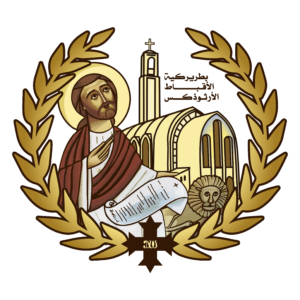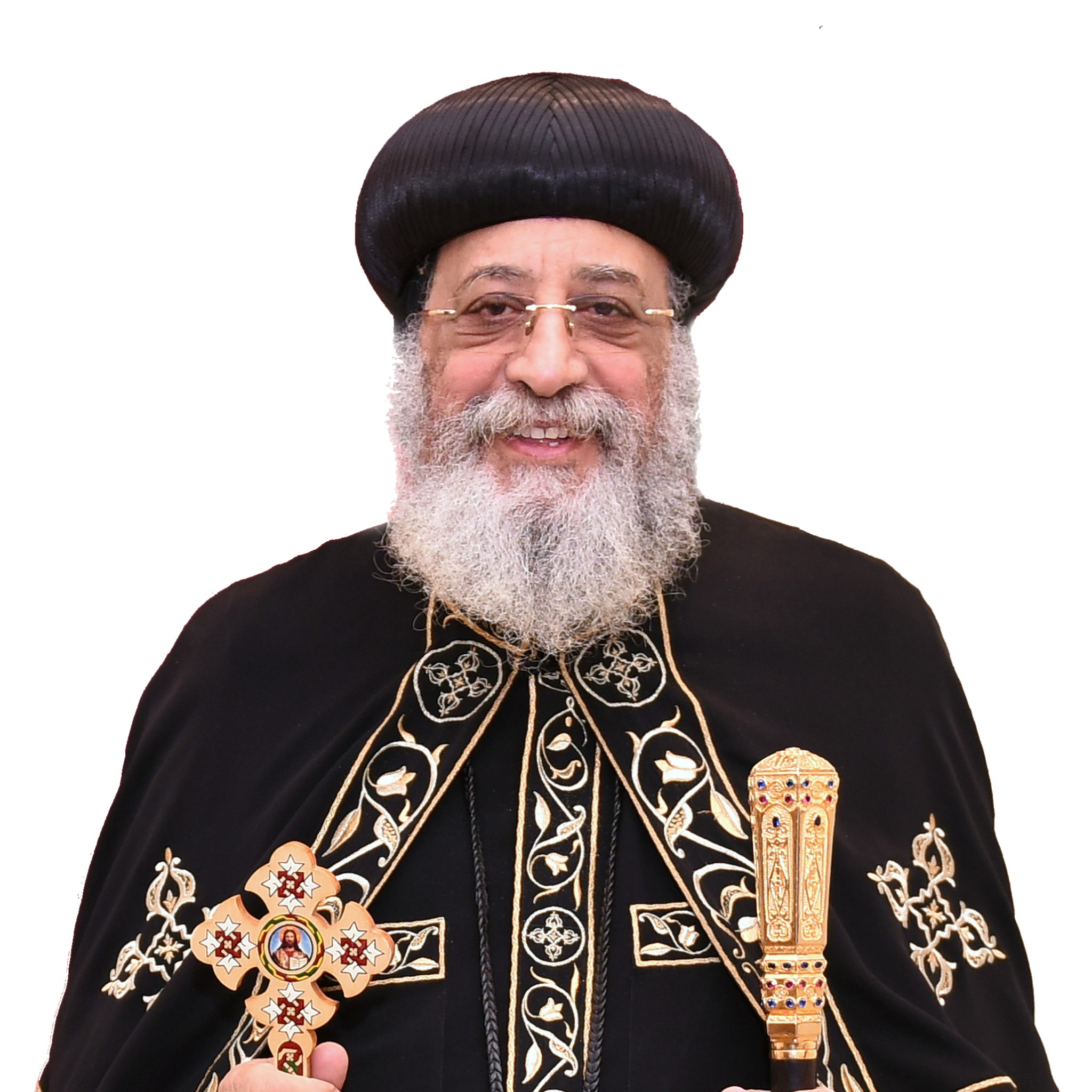Papal Residence
The Journey of St. Mark’s Throne
From Alexandria to the new headquarters in New Administrative Capital
By Maged Kamel
The Coptic Orthodox Church is considered one of the oldest, if not the oldest, apostolic churches in the world. Hence, it is important to give attention to its history and civilization as an integral part of Egypt’s history and cultural heritage. In this article, we will trace the journey of the Throne (See) of St. Mark from the beginning of his preaching in Alexandria until the present day.
First Stop: Alexandria (Approximately 61–1048 AD)
It is historically proven that St. Mark the Apostle came to Alexandria in 61 AD, lighting the first spark of Christianity in Egypt. The history of the Church tells us that one day he was walking by the sea thinking and contemplating where to start preaching in this great city with a magnificent school and major library. His sandals were worn out from walking, so he went to a shoemaker called “Anianus” to fix it. Suddenly, the shoemaker wounded his hand and he subconsciously shouted “O, the one God” due to the severity of the pain. St. Mark the Apostle seized the opportunity and asked him if he wanted to know “the one God.” When he answered, “Yes,” St. Mark began to explain to him the Christian faith until he and his family believed and were baptized. Anianus’ house became the center of preaching the Christian faith in the city. When the number of believers increased, St. Mark the Apostle ordained Anianus the first bishop of Alexandria. After St. Mark ’s martyrdom in 68 AD, his holy relics were kept in a church called “Bokalia,” whose current place is St. Mark’s Cathedral in Mahatet El-Raml, Alexandria, Egypt, and it became the official patriarchal residence.
As for the city of Alexandria, Ali Pasha Mubarak says in volume 4 of his book “Tawfiq’s New Plans” (Al-Khitat Al-Tawfiqiyya Al-Gadida) that it was a small fishermen’s village called “Raqouda.” When Alexander the Great came to Egypt around 322 BC, he established the city of Alexandria and named it after himself, making it the center of trade instead of the city of Tyre. Under the word “Alexandrie,” Émile Amélineau says in his book “La géographie de l’Egypte à l’époque copte” (Geography of Egypt in the Coptic Era) that “the Copts kept its ancient name,” which is “Rakoti.” Moreover, Strabo spoke of its prosperity and trade, and that it was a gateway to Egypt and its trade. The word “Rakoti” is made up of hieroglyphic phrases that mean “That which was built by the god Ra” as it is written in many ancient Coptic manuscripts about it and its districts. In “The Chronicle of John, Bishop of Nikiu” the history of the ancient world, chapter 59, it is written: “And when Alexander the son of Philip of Macedon became king, he built in Egypt the great city Alexandria, and named it Alexandria after his own name. Now its name formerly in the Egyptian language was Rakoti.”
During the persecution against the Coptic Church after the Council of Chalcedon in 451 AD, the 34th Pope, Peter IV (567–569 AD), the 35th Pope, Damian (569–605AD), and the 36th Pope, Anastasius (605–616 AD), were forced to temporarily reside in the Monastery of Glass west of Alexandria until the Arab conquest of Egypt in 641 AD. The patriarchs continued to reside in Alexandria until the papacy of Pope Shenouda II, the 65th Patriarch.
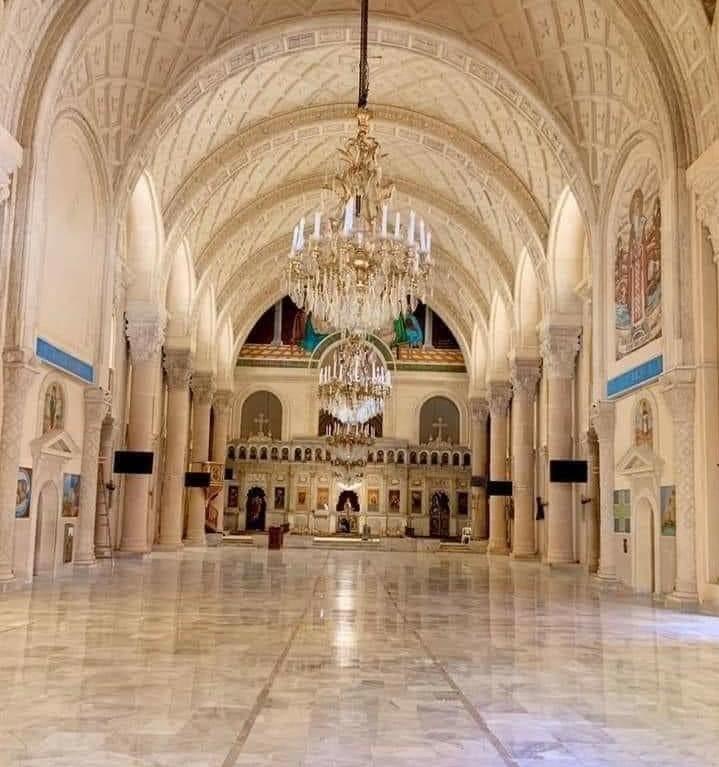
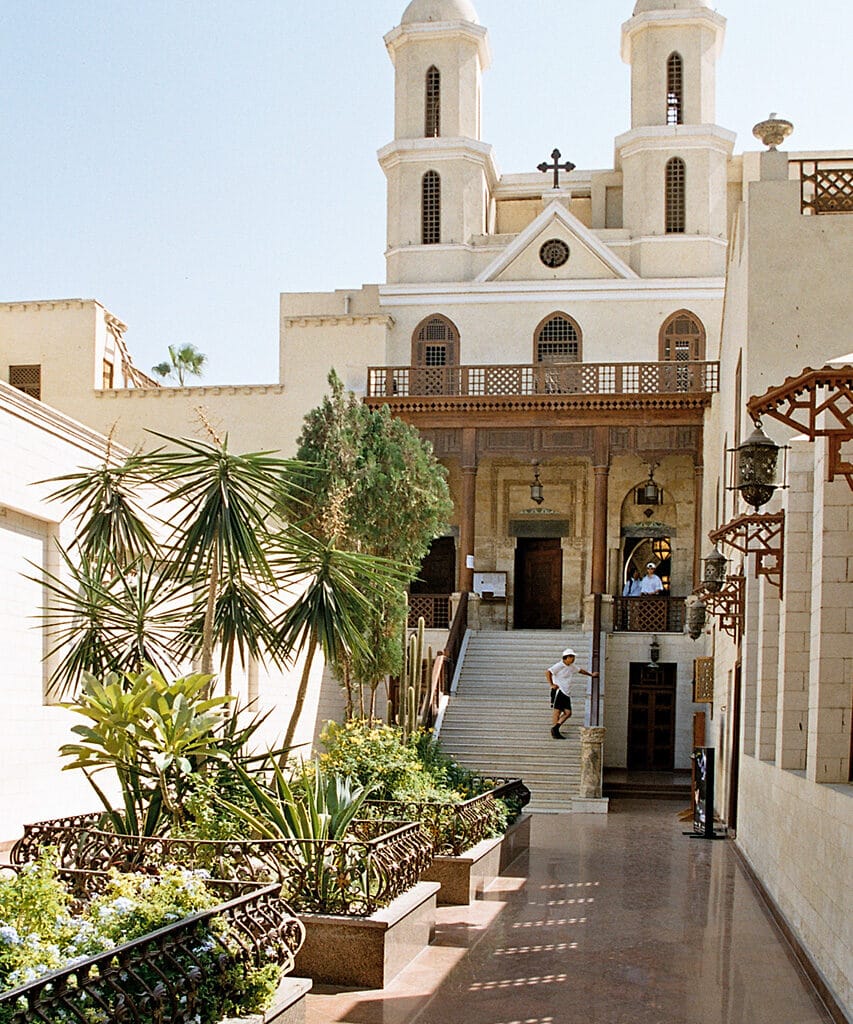
Second Stop: The Church of the Virgin Al-Mu’allaqa (1047–1320 AD)
The city of Cairo was established in 969 AD as the beginning of the Fatimid rule in Egypt. All trade was moved to the new capital, which motivated Pope Christodolos (1046–1077 AD), the 66th Patriarch, to transfer the papal throne to the Church of the Virgin known as “The Hanging Church” (Al-Kanisa Al-Mu’allaqa) in Old Cairo (Masr Al-Qadima). Alfred J. Butler (1850-1936 AD), the famous English historian, said that it was one of the oldest churches remaining in Egypt. The small church dates back to the third or fourth century AD, while the large church dates back to the sixth century AD. Also, it is called the Hanging Church because it was built on the ruins of the Roman Fortress and was built as a basilica with three altars. Al-Maqrizi wrote about in his book “Al-Maqrizi’s Plans” (Kitab Al-Khitatt Al-Maqriziyah) under the title “The Hanging Church in the City of Cairo,” that it was in the area of the “Palace of Wax” (The Babylon Palace in the Babylon Fortress), and was called “Al-Sayeda” (The Lady), and that “it was greatly revered by [the Copts].”
The Hanging Church continued to be the official residence for the Papal Throne until Pope John VIII (1300–1320 AD), the 80th Patriarch, except for some short periods when some popes resided in Abee Seifen Church in Old Cairo.
- Pope Christodolos (1046–1077 AD), 66th Patriarch
- Pope Cyril II (1078–1092 AD), 67th Patriarch
- Pope Michael II (1092–1102 AD), 68th Patriarch
- Pope Macarius II (1102–1128 AD), 69th Patriarch
- Pope Gabriel II (1131–1145 AD), 70th Patriarch
- Pope Michael III (1145–1146 AD), 71st Patriarch
- Pope John V (1147–1166 AD), 72nd Patriarch
- Pope Mark III (1166–1189 AD), 73rd Patriarch
- Pope John VI (1189–1216 AD), 74th Patriarch
- Pope Cyril III (Ibn Laqlaq) (1235–1243 AD), 75th Patriarch
- Pope Athanasius III (1250–1261 AD), 76th Patriarch
- Pope Gabriel III (1268–1271 AD), 77th Patriarch
- Pope John VII (1271–1293 AD), 78th Patriarch
- Pope Theodosius II (1294–1300 AD), 79th Patriarch
Third Stop: The Church of the Virgin in Haret Zuweila (1320–1660 AD)
During the papacy of Pope John VIII (1300–1320 AD), the 80th Patriarch, the Papal Throne was transferred from the Church of the Virgin Al-Mu’allaqa to the Church of the Virgin in Haret Zuweila, which was established in 350 AD. Al-Maqrizi wrote about it saying, “It is a grand church of the Jacobite Christians,” referring to the miaphysite Copts to differentiate them from the Melkites; “It was called ‘Al-Sayeda’” (The Lady). Ali Pasha Mubarak also writes about this church in his book “Tawfiq’s New Plans” (Al-Khitat Al-Tawfiqiyya Al-Gadida), referencing Abu Al-Makarim (A Coptic priest who is known for his book: History of Churches and Monasteries): “In Haret Zuweila there was a grand church whose splendor is found in the erected structures, panels inlaid with ivory and ebony, icons, and gilded golden inscriptions handmade and drawn by Egypt’s Copts…. In that hara (lane), there was also a small church and it was the custom for the presbyters of the grand church to pray in it three times a year:
1. Hosanna Sunday, which is the Sunday before the Passover Feast.
2. The third day after the Passover Feast.
3. The Feast of the Cross, which is the 17th day of the month of Tout.
After officiating the celebration of prayer, they used to come out of the church with their vestments, carrying the Gospel, censors, crosses, olive branches, and lit candles leading them in the way, reading the gospel, and chanting, and rejoicing, and praying for the Caliph and his vizier; then they return and conclude the day and depart.”
As for Alfred J. Butler (1850-1936 AD), he said this about the church: “This is without question the earliest church in the city of Cairo. It lies about 14 ft. below the present average level of the neighborhood—proof enough of its great antiquity. Its length is about 60 ft.” He also points to the wonderful icon that represents St. Mary carrying the Lord Jesus among branches that come out of a Jesse-tree and surrounded by the prophets.
- Pope John VIII (1300–1320 AD), 80th Patriarch
- Pope John IX (1320–1327 AD), 81st Patriarch
- Pope Benjamin II (1327–1339 AD), 82nd Patriarch
- Pope Peter V (1340–1348 AD), 83rd Patriarch
- Pope Mark IV (1348–1363 AD), 84th Patriarch
- Pope John X (1363–1369 AD), 85th Patriarch
- Pope Gabriel IV (1370–1378 AD), 86th Patriarch
- Pope Matthew I (1378–1408 AD), 87th Patriarch
- Pope Gabriel V (1409–1427 AD), 88th Patriarch
- Pope John XI (1427–1452 AD), 89th Patriarch
- Pope Matthew II (1452–1465 AD), 90th Patriarch
- Pope Gabriel VI (1466–1474 AD), 91st Patriarch
- Pope Michael IV (1477–1478 AD), 92nd Patriarch
- Pope John XII (1480–1483 AD), 93rd Patriarch
- Pope John XIII (1484–1524 AD), 94th Patriarch
- Pope Gabriel VII (1525–1568 AD), 95th Patriarch
- Pope John XIV (1571–1586 AD), 96th Patriarch
- Pope Gabriel VIII (1587–1603 AD), 97th Patriarch
- Pope Mark V (1603–1619 AD), 98th Patriarch
- Pope John XV (1619–1629 AD), 99th Patriarch
- Pope Matthew III (1631–1646 AD), 100th Patriarch
- Pope Mark VI (1646–1656 AD), 101st Patriarch
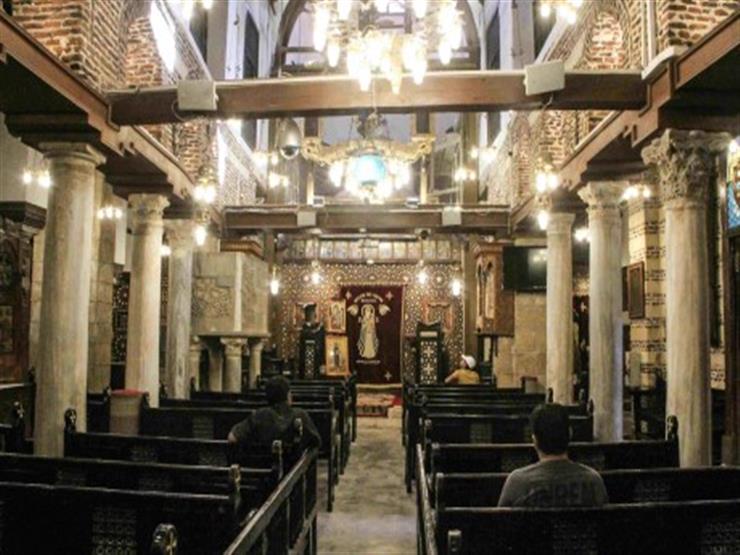
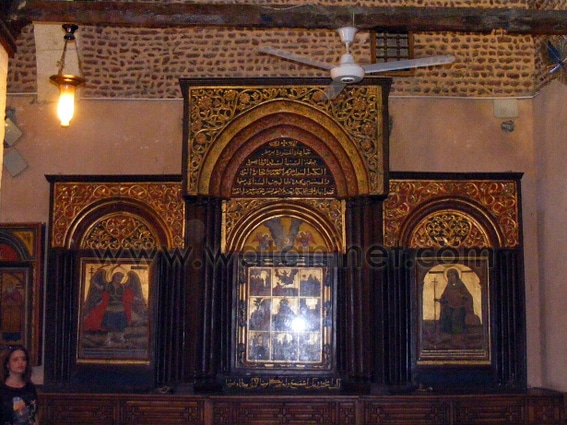
Fourth Stop: The Church of the Virgin of Relief in Haret El-Roum (1660–1799 AD)
During the papacy of Pope Matthew IV (1660–1675 AD), the 102nd Patriarch, the Papal Throne was transferred to the Church of the Virgin in Haret El-Roum (Roman Quarter). It is an ancient church in the area of El-Ghoreyya, El-Darb El-Ahmar, Cairo. Al-Maqrizi wrote about it in his Plans book, saying, “It is a church that is called ‘Al-Mughitha’ (the one of relief) in Haret El-Roum, Cairo, in the name of ‘Al-Sayeda Maryam’ (Mary the Lady).” It was called “Al-Mughitha” as a blessing from the Virgin Mary who rescues and relieves anyone who asks for her prayers and intercessions in time of hardships.
- Pope Matthew IV (1660–1675 AD), 102nd Patriarch
- Pope John XVI (1676–1718 AD), 103rd Patriarch
- Pope Peter VI (1718–1726 AD), 104th Patriarch
- Pope John XVII (1727–1745 AD), 105th Patriarch
- Pope Mark VII (1745–1769 AD), 106th Patriarch
- Pope John XVIII (1769–1796 AD), 107th Patriarch
- Pope Morkos (Mark) VIII (1796–1809 AD), 108th Patriarch
Fifth Stop: St. Mark’s Grand Cathedral in Azbakeya (1799–1971 AD)
Pope Morkos VIII transferred the Papal Throne from Haret El-Roum to St. Mark’s Grand Cathedral in El-Darb El-Wase’. There is a funny story about the building of this church that Ali Pasha Mubarak mentions in volume 6 of his book “Tawfiq’s New Plans” (Al-Khitat Al-Tawfiqiyya Al-Gadida): “The story of building this church: the famous Amir, Al-Moallem Ibrahim El-Gohary, Egypt’s chief of scribes, one of the revered ladies of the Sultanate, possibly the sister of the Sultan, came from Constantinople to Egypt, intending the Hajj. Being a well-known high figure in the government, he personally performed due service, including transporting her to and from places. He also presented her with gifts worthy of her high status. She desired to reward him for his service with her, asking him for what he would want. He asked her to assist in ratifying a decree from the Sultan to establish the Church of Azbakeya since that is where he lived. He also asked for other things, including taking away the jizya (Islamic tax) on behalf of monks; the desires were met except for [the last ask mentioned]. However, he died on the 25th of Bashans, 1511, that is the end of 1209 AH (1795 AD) and before the beginning of building. When his brother, Girgis Afandi took his place, he united with the patriarch and the elites of the nation began to build next to the cell. The construction ended in 1516 AM as we mentioned previously. It is said that the land where the church was built was owned by El-Amir Yacoub and Moallem Malati who held important [government] positions during the reign of the French, and gave it up for the Church and for the Patriarch’s cell to reside in next to the church. It became the first church for the Egyptian churches.”
The church was in fact consecrated for prayer on September 14, 1800 AD, by the hands of Pope Morkos VIII.
For the sake of academic honesty, let us mention what Alfred J. Butler said about this church, which may give us a sense of shock: “The Coptic cathedral, built in the present century, is so ugly and void of interest that it is not worth a visit, except to those who care to see how the Copts of today depart from their own traditions and adopt forms and practices of the Greek Church.” (Butler, Alfred J. (Alfred Joshua), 1850-1936. The Ancient Coptic Churches of Egypt. Oxford: Clarendon press, 1884, pg. 284).
- Pope Mark VIII (1796–1809 AD), 108th Patriarch
- Pope Peter VII (Al-Gawli) (1809–1852 AD), 109th Patriarch
- Pope Cyril IV (The Father of Reform) (1853–1862 AD), 110th Patriarch
- Pope Demetrius II (1862–1870 AD), 111th Patriarch
- Pope Cyril V (1874–1927 AD), 112th Patriarch
- Pope John XIX (1928–1942 AD), 113th Patriarch
- Pope Macarius III (1944–1945 AD), 114th Patriarch
- Pope Joseph II (1946–1956 AD), 115th Patriarch
- Pope Cyril VI (1959–1971 AD), 116th Patriarch


Sixth Stop: St. Mark’s Cathedral in Abbasiyya (1971 AD-Present)
During the Papacy of Pope Kyrillos VI, and specifically on July 24th, 1965, the cornerstone of the new St. Mark’s Cathedral was placed on the land of Anba Rewis in Abbasiyya, in the presence of the late President Gamal Abdel-Nassir. It was officially opened for prayer on June 25th, 1968, in a magnificent celebration that was attended by the late President Gamal Abdel-Nassir and the late Emperor of Ethiopia, Haile Selassie. In this cathedral, the funeral prayers on the spirit of Pope Kyrillos VI took place on March 10th, 1971, as well as the enthronement of Pope Shenouda III, 117th Patriarch, and the funeral prayers on his spirit on March 21st, 2012. Moreover, His Holiness, Pope Tawadros II, 118th Patriarch, was appointed Pope there on November 18th, 2012—may God grant him many years.
This land is known in the history books as “Deir Al-Khandaq.” Al-Maqrizi wrote about it in his Plans book under the title “Deir Al-Khandaq,” saying, “It was outside [the walls] of Cairo from its North; It was built by General Gawhar in place of a monastery he demolished near the Aqmar Mosque where there was a well that was known as ‘The Well of the Bone’ or ‘The Well of Bones’ because there were bones in the monastery that were moved to Deir Al-Khandaq. Then Deir Al-Khandaq was destroyed on Shawwal 14, 687 AH (November 11th, 1288 AD) during the days of Al-Mansur Qalawun. Then that monastery was made new, and two churches were built and will be mentioned with the churches.” In the section for churches, and under the title “The two churches of Al-Khandaq,” he says, “They were outside [the walls] of Cairo; one in the name of ‘Gabriel the Angel,’ and the other in the name of ‘Mercurius,’ and was known as ‘Rewis’ who was a famous monk after the year 800 AH (1397 AD). Near those two churches, the Christians used to bury their dead, and it was known as ‘Al-Khandaq cemetery.’” Ali Pasha Mubarak speaks about this land in volume 6 of his book “Tawfiq’s New Plans” (Al-Khitat Al-Tawfiqiyya Al-Gadida), saying, “It is in the monastery of the St. Anba Freig who is known now as the Monastery of Anba Rewis. It is Deir Al-Khandaq that was mentioned by Al-Maqrizi. Abou Rewis was a respectable worshipper and ascetic to his people who died in 1121 AM, 1405 AD, and buried in the mentioned monastery.”
On a historic day, H.H. Pope Tawadros II, accompanied by 107 metropolitans and bishops, consecrated St. Mark’s Cathedral on November 18th, 2018, by consecrating the three main altars, the Pantocrator Icon, and about 200 new icons in the cathedral.
Seventh Stop: The Cathedral of the Nativity in New Administrative Capital
It was officially opened on January 6th, 2019, by H.H. Pope Tawadros II, in the presence of President Abdel-Fattah El-Sisi. It is considered to be the largest cathedral as it is built on 15 feddans (15.57 acres) of an area of 63,000 sq m (678126.36 sq ft) and can accommodate up to 8,000 individuals. It includes the Papal Residence, a reception hall, a conference hall, and administrative offices, as well as a large museum for the history of the Coptic Church. The icons in the cathedral consist of narratives of the Nativity of our Lord and the Annunciation to the Virgin Mary, as well as some from the Book of Revelation.
This is the Journey of St. Mark’s Throne From Alexandria to the new headquarters in New Administrative Capital.
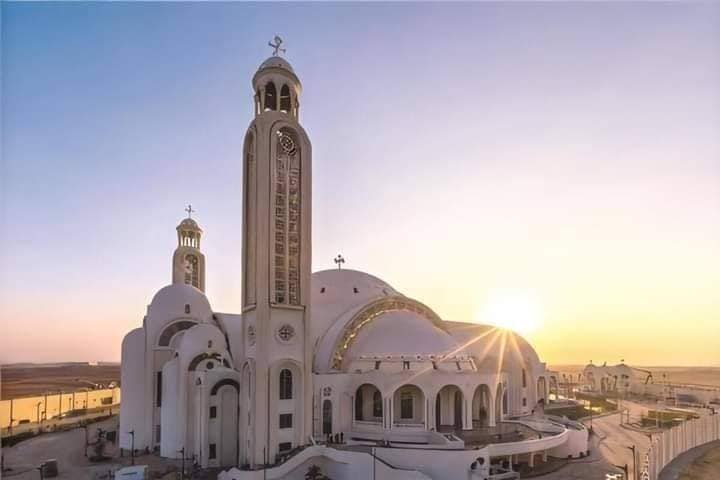
This page is also available in:
العربية
